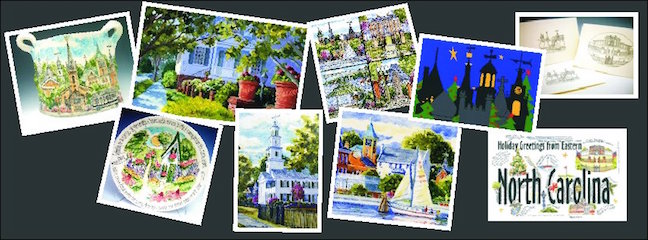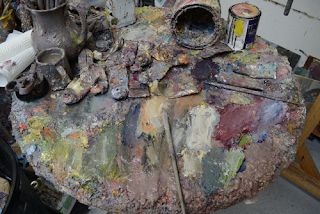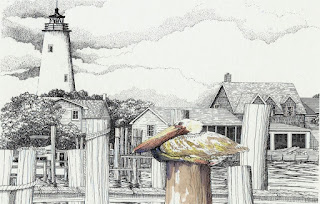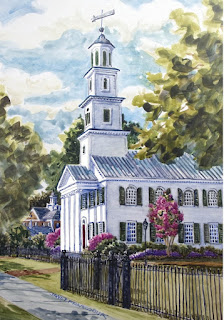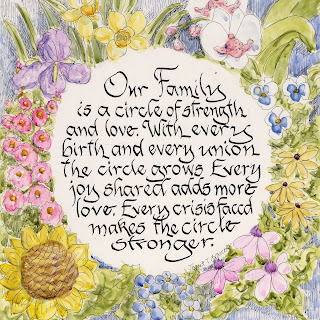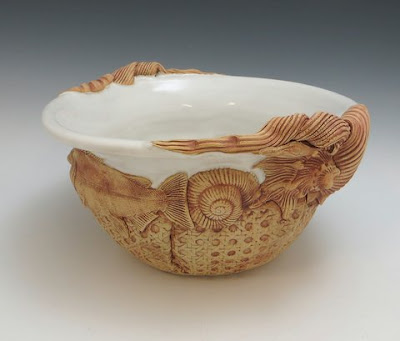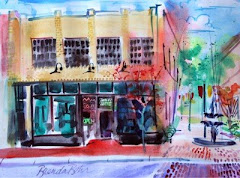We are thrilled to be representing William Hays with his reduction linocuts at Carolina Creations.
William Hays has been creating beautiful works of art for more than 40 years. He began painting in watercolors as a teenager and eventually ended up with a degree in sculpture from the University of Alaska in Anchorage. After moving to the lower 48 from Alaska in 1987, he concentrated on painting in oils. He was regularly recognized as one of the region's leading painters creating primarily landscape images. Since 2012 Hays has concentrated on printmaking.
This is a very labor intensive type of printmaking. William was kind enough to post photos of each step as he pulls the edition.
The linoleum used is called battleship linoleum.
The waste is cut away with a tool like these.
Then the oil based ink is applied with a brayer. It's interesting that you can tell when the ink is ready to be rolled onto the linoleum because it makes a snapping sound!
What
follows is a step-by-step explanation of a reduction linocut print with
illustrations. I hope you will find it interesting. I do.
The carved
linoleum block ready for the first color printing. It took two days to
do the drawing on the block (in blue indelible marker) and almost
another two days to do the carving for this first stage. The initial
stages are often very time consuming and get lighter as the print
progresses, sometimes.... The blue gray is the original surface of the
block with the tan areas being the carved portions.
Step 1:
Here is the print of the first color from the carved block above. As you
can see, there is much planning that goes into anticipating what will
happen as the subsequent colors are added.
This is
the block after carving in preparation for the second color. I would
love to tell you that this didn't take as long as the first stage, but
it did. You'll note that the block is backward from what is printed.
This creates issues when there is type involved in the image and I've
made the mistake of not remembering this before... oops. The original
surface is still blue-gray. The first stage of carving is stained a
milky light blue from the first ink. The second stage carving is tan.
Step 2:
Here's the print with the second color added. Although it is beginning
to take shape, there is much more to add from here. You'll note the
three holes on the left-hand side of the paper. These are fitted to pins
on the press bed to keep the paper in the same position every time so
that the colors line up (register) correctly. This tab is removed after
the print is finished.
Step 3:
(No need to show you the block each time.) Now it's really coming
together with the third color and you can clearly see where it is going
from here.
Step 4:
The fourth impression involved the use of two colors. The ink is applied
to the block with the brayer. Because there is significant space between the two colors, I
can roll them on separately without overlap. The upper color
(violet-gray) uses a fair amount of opaque white and breaks the usual
order of color application (light to dark) by going lighter than the
previous color.
Step 5:
This impression also used two colors - a dark violet-gray on top and a
dark brown-green on the bottom. You can see that the nature of the image
has changed considerably with the addition of these dark darks. It
begins to really snap together.
This is what the block looks like after all the carving is done and before printing the last color.
"Seaside Rest" 8-color Linoleum Block Print, 9" x 12"
Step 6: The final color, a violet-black pulls everything together
and the print is finished. I started out with 48 sheets of paper and
ended up with 39 acceptable prints. The rest had registration problems
where the paper stretches or the block shifts during printing. The
result is an uncomfortable double image look that I don't include in the
edition. I let the print completely dry for a couple of days (oil-based
inks), trim off the registration tab and then sign and number each
print to finish off the process.
We hope you'll come in and see more of William's work.
